|
|
| |
|
|
| |
|
|
|
|
| |
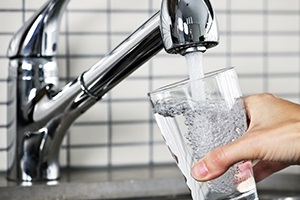 Climate
Impacts on Water Resources Climate
Impacts on Water Resources
Overview
Water resources are important to both society and
ecosystems. We depend on a reliable, clean supply of
drinking water to sustain our health. We also need water for
agriculture, energy production, navigation, recreation, and
manufacturing. Many of these uses put pressure on water
resources, stresses that are likely to be exacerbated by
climate change. |
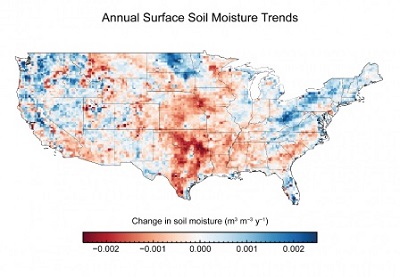 In
many areas, climate change is likely to increase water
demand while shrinking water supplies. This shifting balance
would challenge water managers to simultaneously meet the
needs of growing communities, sensitive ecosystems, farmers,
ranchers, energy producers, and manufacturers. In
many areas, climate change is likely to increase water
demand while shrinking water supplies. This shifting balance
would challenge water managers to simultaneously meet the
needs of growing communities, sensitive ecosystems, farmers,
ranchers, energy producers, and manufacturers.
Picture - Observed
trends in annual surface soil moisture per year between 1988
and 2010 based on satellite data. USGCRP (2014)
In some areas, water shortages will be less of a problem
than increases in runoff, flooding, or sea level rise. These
effects can reduce the quality of water and can damage the
infrastructure that we use to transport and deliver water. |
|
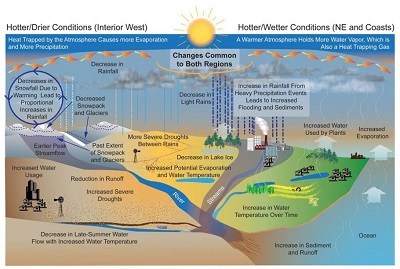 Water
Cycle and Water Demand Water
Cycle and Water Demand
The water cycle (shown in the following figure) is a
delicate balance of precipitation, evaporation, and all of
the steps in between. Warmer temperatures increase the rate
of evaporation of water into the atmosphere, in effect
increasing the atmosphere's capacity to "hold" water.
Increased evaporation may dry out some areas and fall as
excess precipitation on other areas.
Picture - Projected
changes in the water cycle. Source: USGCRP 2009
Changes in the amount of rain falling during storms provide
evidence that the water cycle is already changing. Over the
past 50 years, the amount of rain falling during very heavy
precipitation events has increased for most of the United
States. This trend has been greatest in the Northeast,
Midwest, and upper Great Plains, where the amount of rain
falling during the most intense 1% of storms has increased
more than 30%. Warming winter temperatures cause more
precipitation to fall as rain rather than snow. Furthermore,
rising temperatures cause snow to begin melting earlier in
the year. This alters the timing of streamflow in rivers
that have their sources in mountainous areas.
As temperatures rise, people and animals need more water to
maintain their health and thrive. Many important economic
activities, like producing energy at power plants, raising
livestock, and growing food crops, also require water. The
amount of water available for these activities may be
reduced as Earth warms and if competition for water
resources increases. |
|
|
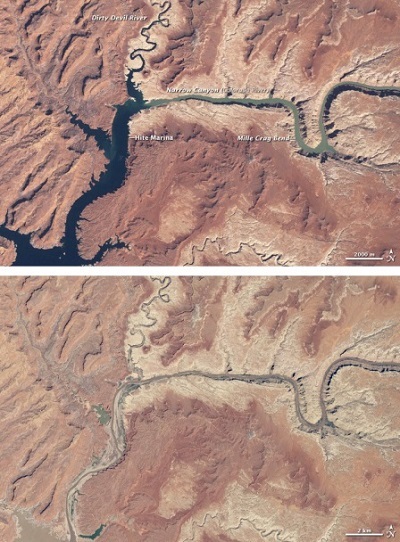 Water
Supply Water
Supply
Many areas of the United States, especially the West,
currently face water shortages. The amount of water
available in these areas is already limited, and demand will
continue to rise as population grows. Many areas in the West
have experienced less rain over the past 50 years, as well
as increases in the severity and length of droughts; this
has been especially of concern in the Southwest.
Picture - Matching
satellite images show the decline in Lake Powell and the
Colorado River between 1999 and 2014. NASA (2014)
In the western part of the United States, less total annual
rainfall, less snowpack in the mountains, and earlier
snowmelt mean that less water will likely be available
during the summer months when demand is highest. This will
make it more difficult for water managers to satisfy water
demands throughout the course of the year. |
|
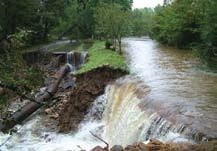 Water
Quality Water
Quality
Water quality could suffer in areas experiencing increases
in rainfall. For example, in the Northeast and Midwest
increases in heavy precipitation events could cause problems
for the water infrastructure, as sewer systems and water
treatment plants are overwhelmed by the increased volumes of
water. Heavy downpours can increase the amount of runoff
into rivers and lakes, washing sediment, nutrients,
pollutants, trash, animal waste, and other materials into
water supplies, making them unusable, unsafe, or in need of
water treatment. For information about how climate change
and water quality affect public health, visit the Health
Impacts & Adaptation page.
Picture - Heavy rain
in 2004 damaged the city water system in Asheville, North
Carolina. Source: USGCRP (2009)
Freshwater resources along the coasts face risks from sea
level rise. As the sea rises, saltwater moves into
freshwater areas. This may force water managers to seek
other sources of fresh water, or increase the need for
desalination (or removal of salt from the water) for some
coastal freshwater aquifers used as drinking water supply.
In addition, as more freshwater is removed from rivers for
human use, saltwater will move farther upstream. Drought can
cause coastal water resources to become more saline as
freshwater supplies from rivers are reduced. Water
infrastructure in coastal cities, including sewer systems
and wastewater treatment facilities, faces risks from rising
sea levels and the damaging impacts of storm surges. |
|
|
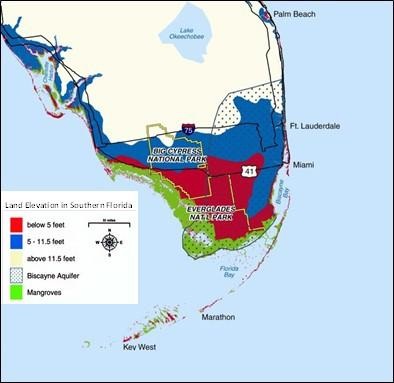 Impacts
of Changes in Water Resources on Other Sectors Impacts
of Changes in Water Resources on Other Sectors
The impacts of climate change on water availability and
water quality will affect many sectors, including energy
production, infrastructure, human health, agriculture, and
ecosystems.
Picture - The Biscayne
Aquifer provides almost all of the freshwater for the Keys,
Miami, and the lower East Coast of Florida. Although a small
part of the aquifer is beneath salty mangrove area, most of
it is recharged by the freshwater Everglades. As sea level
rises, saltwater will invade part of the Everglades,
threatening both that ecosystem and the aquifer that lies
beneath it.
Source: EPA (2002)
For more information on these impacts, please visit the
following impacts pages:
Agriculture
Ecosystems
Energy
Human Health
International
Society |
|
|
EPA Page |
|
This is the
EPA page for this topic. To see if the Trump
administration has changed the EPA page, simply click the
link and compare the information with this page. If you
notice changes were made to the EPA page, please post a
comment. Thanks. |
|
|
Key Points
Warming temperatures, changes in precipitation and runoff,
and sea level rise have affected and will likely continue to
affect water supply and quality.
Changes will vary in different regions of the United States;
potential effects include increased flooding and drought,
water quality impairment, and salt water intrusion to
coastal water supplies.
Changes to our water resources affect many sectors,
including energy production, infrastructure, human health,
agriculture, and ecosystems.
Colorado River Water Supply
The Colorado River system is a major source of water supply
for the Southwest. It supplies water for 33 million people
in the cities of Los Angeles, Phoenix, Las Vegas, and
Denver. Recent droughts, reductions in winter precipitation
and snow pack, and warmer, drier springs have caused water
supplies in Colorado River reservoirs to decrease. Expected
climate change impacts on Colorado River water supply
include:
Increased year-to-year changes in water storage in
reservoirs are possible, even under current conditions.
Decreased hydropower. For every 1% decrease in streamflow in
the Colorado River Basin, there is a 3% decrease in
hydroelectric power generation for the region.
Reductions in river discharge and runoff from snowmelt.
Annual snowmelt runoff could also shift to earlier in the
spring.
Coastal Water Supply
The quality of water supply in coastal and island regions is
at risk from rising sea level and changes in precipitation.
Rising sea level and the occurrence of drought can increase
the salinity of both surface water and ground water through
salt water intrusion.
For example, the freshwater Everglades currently recharge
Florida's Biscayne aquifer, a natural underground area that
collects water and is the primary water supply to the
Florida Keys. If rising sea levels submerge low-lying areas
of the Everglades, portions of the aquifer would become
saline. Sea level rise can also push salty water upstream in
coastal areas, threatening surface water supplies. Aquifers
in New Jersey east of Philadelphia are recharged by fresh
portions of the Delaware River, which become saline during
severe droughts.
Freshwater resources on some islands, especially small
islands and atolls, can be limited, as supply depends on
shallow aquifers, which are recharged by precipitation.
These freshwater lenses float on top of the saltwater, and
rising sea level diminishes the area above sea level in
which the lens can reside. (For more detailed information,
see the illustration on page 158 of this Climate Change
Science Program Report(320 pp, 7.6 M, About PDF)). Sea level
rise can turn these shallow aquifers brackish through
saltwater intrusion and droughts reduce the water available
from other sources, further stressing these limited water
supplies. |
|
|
|
|
|
|
|
|
|
|
|
|
Additional Climate Change Information |
Climate Change and Carbon Dioxide
(Beginner - Listening,
reading)
A video lesson to
help with your understanding of climate change
and carbon dioxide.
The English is
spoken at 75% of normal speed.
Great English listening and reading practice. |
Carbon Dioxide and Climate Change
(Beginner - Listening,
reading)
A video lesson to
help with your understanding of carbon dioxide
and climate change.
The English is
spoken at 75% of normal speed.
Great English listening and reading practice. |
Environmental Group Warns Earth's Health at Risk
(Beginner - Listening,
reading)
A video lesson to
help with your understanding of climate change.
The English is
spoken at 75% of normal speed.
Great English listening and reading practice.
A report by the World Wildlife Fund looked at thousands of animal populations
and found they have dropped significantly in 40 years. |
Sea Levels Rising at Fastest Rate in 3,000 years
(Beginner - Listening,
reading)
A video lesson to
help with your understanding of climate change.
The English is
spoken at 75% of normal speed.
Great English listening and reading practice.
A group of scientists say sea levels are rising at record rates. Another group
found that January temperatures in the Arctic reached a record high. |
Capturing CO2 Gas Is Not Easy
(Beginner - Listening,
reading)
A video lesson to
help with your understanding of climate change.
The English is
spoken at 75% of normal speed.
Great English listening and reading practice.
Most scientists agree that carbon-dioxide gas is partly to blame for climate
change: rising global temperatures. But capturing the CO2 gas released by power
stations is costly and difficult. |
Growth, Climate Change Threaten African Plants and
Animals
(Beginner - Listening,
reading)
A video lesson to
help with your understanding of climate change.
The English is
spoken at 75% of normal speed.
Great English listening and reading practice.
Researchers believe Africa may lose as much as 30 percent of its animal and
plant species by the end of this century. |
|
|
|
|
Search Fun Easy English |
|
|
|
|
|
|
|
|
|
|
|
|
|
|
|
About
Contact
Copyright
Resources
Site Map |